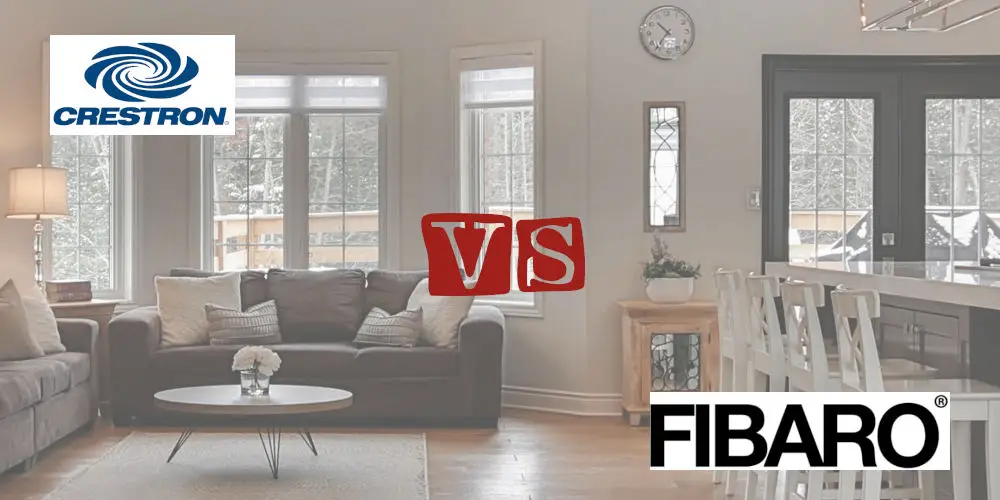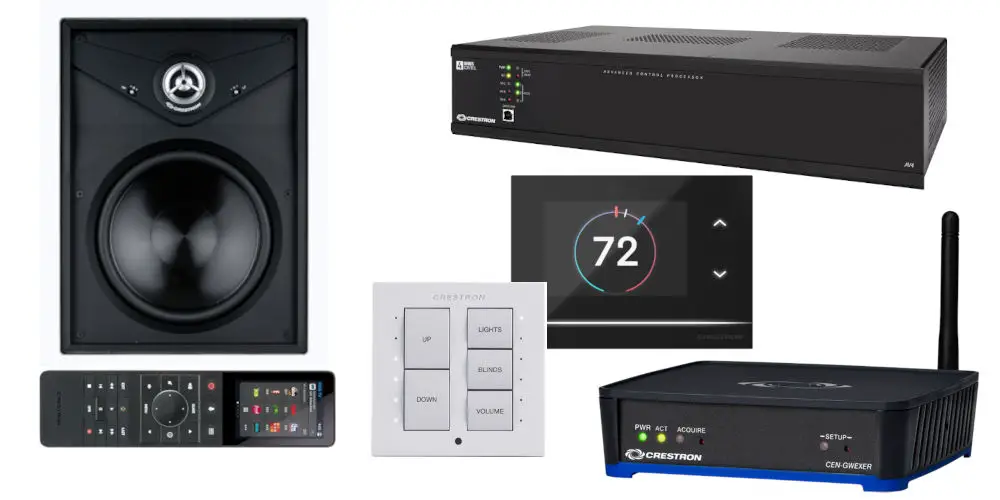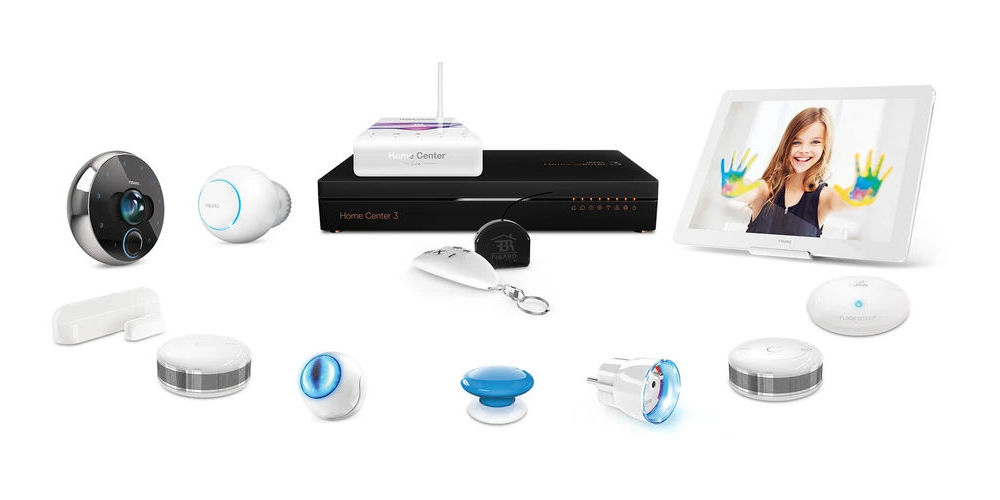Crestron vs Fibaro home automation: Which is best?

It might seem weird to compare Crestron vs Fibaro. One is A DIY home automation system, while the other is a professional level system. However, when considering your options, it’s worth looking at every possible solution.
What makes comparing these smart home systems interesting is they achieve similar outcomes yet use completely different methodologies.
On one side, Fibaro, which is a widely available, DIY friendly solution that uses wireless technology and a mesh network. Only available from dealers, Crestron is a wired system that’s complex to install and configure, hence the need to work with an approved dealer.
Even with this brief outline, you should be able to appreciate some of the main differences between Crestron and Fibaro.
Let’s explore each system in detail, looking at what makes them unique. Next, we will try to draw a fair comparison between the two, enabling you to make an informed buying decision when choosing between Crestron vs Fibaro.
Crestron home automation

photo by Crestron
History
Founded in 1971 by inventor and engineer George Feldstein, Crestron Electronics is one of the oldest home automation companies in the world. Based in New Jersey, USA, the company designs, manufactures, and distributes smart home and audiovisual equipment using a global dealer network.
Much like other high-end home automation systems, you can’t buy products directly from Crestron. Instead, they use a global network of dealers to design, install and configure automation systems.
There are many uses for Crestron home automation products, with luxury homes only being a small part of their business. They also supply the US government, Microsoft, hotels, hospitals and schools.
Crestron provides complete control of every element, both within the home and office. Easily operate lights, heating, gates, TVs and a home cinema room, both in person and remotely using Wi-Fi.
How does Crestron works?
Using a wired network, Crestron requires your home to be rewired. At the heart of the system is rack-mounted modules that control the system and devices are wired into these. That said, the majority of the controllers are battery-powered, wireless units.
Despite its wired network, integrating wireless devices, including Amazon Alexa, Sonos smart speakers, and Google Assistant into a system is effortless. These add-ons increase the number of functions the user can control.
Unless you know what your doing, installing and configuring Crestron devices isn’t possible. Hence the need to work with an approved highly trained dealer. That said, once installed, a Crestron system is rock solid.
One downside of having to buy devices using a dealer is they are free to set the price. That said, you might be able to negotiate a good deal by playing two dealers off each other! The buying experience is completely different from asking a local electrician to install a few smart sockets!
Each system is unique to the client, their home and their requirements. If you compared two homes that use a Crestron system, you’d quickly realise that each will act, look and feel differently.
Is it DIY friendly?
Designed for performance, not ease of installation, unless you’ve worked with Crestron devices before, you’ll want to hire a dealer. Of course, they aren’t cheap as they are highly trained and work with the Crestron ecosystem daily.
Many wrongly believe they can watch eBay for second-hand devices and try to cobble a system together. While devices occasionally appear on online marketplaces, you’d be waiting years for every device that you need to be available for sale.
You’ll, therefore, need to work with a dealer from conception to installation and configuration to ensure you have a system that aligns with your requirements.
Current product range
Crestron provides a range of products and solutions to build a fully automated home. They offer sophisticated lighting control, including options to program complex scenes and sequences, controllable by a single button.
Automate your blinds and curtains, so they close on cue whether you’re at home or away. Enjoy superior multi-room audio and video, thanks to Crestron DigitalMedia™ technology, and a range of switchers, amplifiers and speakers. Even Sonos products seamlessly integrate into the system.
The system offers flexible temperature control that uses data from multiple sensors placed around the property. Your home’s temperature will be constant, ensuring you are always warm.
Crestron provides a range of solutions to keep your home safe and secure. Secure your front door with a Yale lock and video intercom, and control your garage and gate using the system. You can even add a range of security cameras.
The current Crestron Home™ OS 3 delivers a simple, clean, and sophisticated user experience. Control your entire system from a single point using a remote, touch screen or app.
Any downsides?
As your property need to be rewired as part of the installation process, Crestron isn’t designed for historic or listed buildings. Ideally, the system is best for new builds. As you might expect, running new cables around your home isn’t cheap, and labour costs can quickly add up.
Most homeowners spend £75,000 plus when adding a Crestron system. So, it’s hardly a system you would install on a whim or try to DIY. As you have to work with a dealer, it takes time to install and configure a system. You can’t get up and running overnight.
As devices are only available from dealers, Crestron devices are costly, and finding a price list can be tricky. Dealers don’t want to be knocked down on price or have clients trying to remove features to save money.
As new software and firmware updates become available, you’ll need to pay your dealer to send their engineer out to apply the latest updates as you can’t do this yourself.
Fibaro smart home

photos by Fibaro
History
Headquartered in Poznan, Poland, Fibaro launched in 2010. Today, their products can be found in over 100 countries and are affordable to buy. Fibaro is widely considered to be one of the most advanced wireless smart home systems.
Devices are designed around the Z-Wave protocol, allowing them compatibility with thousands of 3rd party devices. All devices work are compatible with the Apple HomeKit protocol, offering even more options to automate your home.
Fibaro offers devices to control every aspect of your home. You can operate the system from anywhere with Wi-Fi. The system also works with Google Assistant and Amazon Alexa, allowing you to use voice commands for control.
How does Fibaro works?
All devices are built using the Z-Wave chip, allowing for a much wider range than Bluetooth and yet is a lower power alternative to Wi-Fi. At the heart of the system is a hub that sends and receives control signals to devices.
Using two-way communication, devices can repeat messages and also acknowledge they’ve received messages. As devices have a 30-metre range, the network can adapt itself to ensure signals are routed in the best possible way to avoid any dead-spots.
Fibaro rigorously tested 3rd party products to ensure seamless integration and ease of use within their eco-system. Also, they continually invest in their app and website.
Is it DIY friendly?
Fibaro offers a good mix of retrofittable and plug-in and play products, allowing you to add the technology to your home without creating an eyesore. Once devices are installed, they need to be paired with the hub for them to work as part of the system.
Current product range
Fibaro offers a solid product range with multiple hubs available (Home Center 2 and 3). They also offer a few different sensors, relays, sockets and even a smart TRV valve that allows you to add smart technology to your radiators.
Not to mention a few controllers including Swipe (read our review), which uses hand motion to activate pre-set scenes, allowing you to control multiple devices with ease. Fibaro even offer a smart intercom, so you can see who’s at the door and communicate with them regardless of where you are!
Also as a Z-Wave compatible system, if Fibaro doesn’t offer a particular product, you can always use a device from a 3rd party brand. There are thousands of Z-Wave compatible products currently on the market! So, you should be able to find a device to complete the task!
There are several multi-room audio systems that work with Fibaro, allowing you to control them from the app.
Any downsides?
As a wireless smart home system, you’ll likely experience drop-out. However, these should be very rare.
With new products being released and old Z-Wave chips discontinued, there will always be the need to update software and firmware. Some have had issues with software releases, resulting in reprogramming the system or restoring software to a previous version.
Even as a Z-Wave compatible system, not every 3rd party device will work with Fibaro, despite what the packaging says. Before buying any devices, you’ll need to do some research to ensure they will interact without issue.
Crestron vs Fibaro
Having looked at both of the systems in detail, you might wonder which is better? So, let’s compare Crestron vs Fibaro.
Crestron
Only available from approved dealers, Crestron is a highly flexible system initially designed for commercial uses. To become a Crestron dealer, you have to complete extensive training to ensure the customer receives an unrivalled buying experience and support.
One of the benefits of buying a Crestron system is they rigorously test products before releasing them. They also evaluate numerous third party products using the same extensive process to ensure they work faultlessly with Crestron.
Using a wired network means the system doesn’t rely on Wi-Fi to operate. There is only a minimal risk of dropouts or connection issues. That said, many wireless devices work with the system, including the Crestron app that’s available for phones and tablets.
Arguably the biggest unique selling point is the dealer takes care of designing, installing and configuring the system. Once you’ve agreed on what the system will control, the dealer will manage the project until completion.
Of course, having someone else design, install and configure your system comes at a high price. It can also be quite expensive to keep a Crestron system up to date and running smoothly.
Fibaro
Fibaro is highly affordable, DIY friendly and easy to configure. As products use the Z-Wave chip, you have access to thousands of products off the shelf. Once you have a Fibaro hub, you can slowly add elements to form a home automation system, allowing you to go at your own pace.
That said, support can be patchy and you might have to do a lot of research. You might struggle to integrate different manufacturers products into your system, even if they should be compatible.
As Fibaro is a wireless system, you could experience drop-outs or issues if your Wi-Fi stops, or if you try to use devices outside of your router’s range.

Picking a winner: Crestron vs Fibaro!
On the surface, both Crestron and Fibaro achieve a similar outcome of automating your home. That said, they each use a completely different method and logic. You could settle the Crestron vs Fibaro debate by considering your property’s value.
If you live in a modern property that’s worth over £1,000,000, then you’ll probably have the budget to install a Crestron system. For properties under this figure, Fibaro might be ideal, especially if it’s a historic building that would be difficult to rewire.
If you’re just starting your smart home journey, Fibaro is a fantastic option. It allows you to build a home automation system at your own pace.
Crestron should ideally be installed all at once and so requires a large budget. You’ll need to know what you’d like automated upfront, then work with a dealer to make the system a reality. Of course, part of the cost is having someone else install and configure your Crestron system.
Hopefully, that gives you a clearer idea when choosing between Crestron vs Fibaro.




